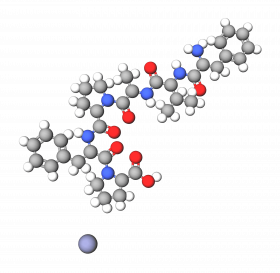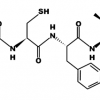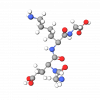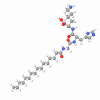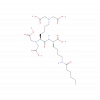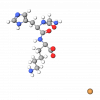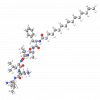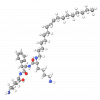Many eukaryotic microorganisms, like Saccharomyces cerevisiae, developed protective mechanisms in response to environmental damaging factors like UV exposure, temperature changes (excess heat or freezing), or oxidative agents like ozone. They produce protective peptides that promote proliferation and increase cell viability.
Hexapeptide-11 with sequence Phe-Val-Ala-Pro-Phe-Pro (FVAPFP), known under the trade name Peptamide™ 6, is one of the peptides found in stressed yeast lysate extracts, which possesses extraordinary biological activity on the skin cells. It promotes regenerative processes, accelerates wound healing, and leaves an overall anti-aging effect.
Zinc Hexapeptide-11 is a metal-complexed cosmetic peptide. According to the manufacturer's claims, it is a multifunctional biologically active zinc-ion-complexed-peptide that decreases proinflammatory TNF-α (Tumor Necrosis Factor-alpha) production and melanin synthesis, inhibiting calcium ion influx.
It also inhibits MMPs (Matrix metalloproteinases) via the PPAR (Peroxisome Proliferator-Activated Receptor) signaling pathway, lessening collagen degradation. In short, Zinc Hexapeptide-11 can leave anti-inflammatory (anti-acne), skin-whitening, and firming effects on the skin.On the other hand, manufacturers claim that Zinc Hexapeptide-11 enhances hyaluronic acid and collagen production and improves KLKs (Kallikreins) activity. Kallikreins are proteases regulating natural desquamation; they break down proteins responsible for keratinocyte cohesion. So, Zinc Hexapeptide-11 enhances skin hydration, elasticity, and renewal. It is frequently used with Hexapeptide-11 in a complex for a synergic potentiating effect.
References
Simplified explanation
Some microbes, like yeast, protect themselves from stress (factors like UV light, heat, or pollution) by making special compounds that help cells survive. Hexapeptide-11 (also called Peptamide™ 6) is an artificial version of one of those compounds that helps skin heal, renew, and look younger.
Zinc Hexapeptide-11 is a modified version combined with zinc. The company that makes it says it can calm skin, lighten dark spots, and protect collagen (which keeps skin firm) from breakdown. It might also help skin stay moist, stretchy, and fresh by helping it shed old or dull cells.
